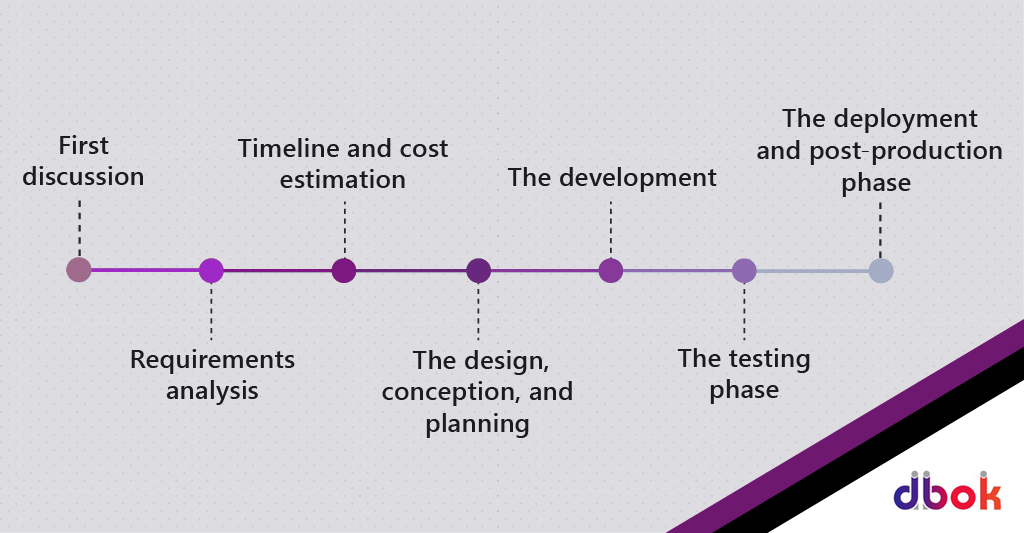Web Application Development Process Flow
Before creating a web application. there is a key success for a project of any size, few steps are mentioned below about our web application development process. Each stage that can take part in the project and map their area of responsibilities.

FIRST DISCUSSION
The first steps aim to give an overview of the requirement. if the requirement isn’t well understood it will lead to a failure in building a web application. we have mentioned following which needs to be answered in this first step.
- What are the primary needs behind the application to be built?
- What problems should the application solve?
- What needs do the application fill? What will be the impact on our business?
- How will the application be used?
- What could be the consequences of the delay in building the application for our business?
REQUIREMENTS ANALYSIS
In the earlier step, the objective was to recognize the purpose of web application execution. The objective can be complex, the business reason being often quite complex in general. It is necessary at this stage that these objectives can be broken down into more manageable tasks and as a result easier to implement, validate, and test.
At the conclusion of this step, the following tasks should have been completed:
-
Reformulate the fundamental requirements and goal.
-
Think in terms of steps required to complete the project.
-
Classify each different feature and module.
-
Break down every goal into simple tasks.
-
Consolidate the different analysis and approaches in a document so that validation can be carried out.
TIMELINE AND COST ESTIMATION
Creating an estimation of the project experience leads to be a good assistant.if a related task has been before.it becomes easier to give an exact estimate and time tracking becomes our suggestion. From the earlier step, we are able to have all the pieces we are going to put together from end to end. For each task, we analyze its complexity and do a categorization.
-
Execute a complexity analysis of each task.
-
Categorize each task.
-
List all required development for each task: UI, logic, test.
THE DESIGN, CONCEPTION, AND PLANNING
In the earlier step time estimation give us an idea of the time required to complete the project. Now in this step, Our objective is to answer the following questions.
-
Organize each task in order to know which one should/must go before another.
-
Analyze dependency between all the tasks.
-
Classify every task that can be done in parallel.
-
Detailed a timeline according to existing resources or in case it is possible to have all the resources we require, analyze the number of resources needed and then plan the project.
-
create an architectural choice.
THE DEVELOPMENT
In the previous steps, Once the requirement analysis is to be done, the development stage can start. The aim of the development stage is to create an application that meets the requirement in the previous steps, develop new ideas of implementation may arise during the implementation phase. it is usually advised to use a methodology that allows flexibility and proactivity.
Each iteration in Agile methodology, we make sure that development is achieved towards the goals defined in the product requirements document.
To implement all features product requirements documentation should be used, make sure that the codes are behaving as expected by the specification document. TDD is one approach that aims to make sure that tests are dressed to test and simulate real behavior. Testing helps us in the development process to understand code purposes and create the process easier. A good coverage has proven to minimize the bugs and it’s proof of the superior design for post-production support and maintenance.
THE TESTING PHASE
During this phase which is also called UAT(User Acceptance Test), a test group of users validates the set of feature and report bugs if any changes to be made, they can be discussed with the higher authority like a project manager who will recommend about the best way to take inputs and feedback into consideration.
THE DEPLOYMENT AND POST-PRODUCTION PHASE
Once every aspect in a given release was validated and all the bugs reported fixed, the deployment phase can start, it may be a first launch or deployment of a new release, this is the moment when the web application will run in its real environment.
In the earlier steps, every aspect in a given release was validated and all the reported bugs to be fixed, then deployment phase can start, it may be launch or deployment of a new release, this is the moment when the web application will run in its real environment.
Some behavior appeared only in the production environment such as load balancer performance. It,s necessary to allocate time for support and maintenance in order to fix any bugs or performance issue that are discovered after the web application went live
Some behavior only appears in a production environment such as load balancer performance, it is important to allow times for support and maintenance in order to fix any bugs or performance issue that are discovered after the application went live.
New ideas for extension may appear once the application is up and running, post-production phase is the best moment to talk about other needs.
WHO IS INVOLVED IN THE WEB APPLICATION DEVELOPMENT PROCESS FLOW?
From the web application development lifecycle we can identify the required participants in order to run this project smoothly. They are:
The project manager: manage the project through its completion, mend the gap between the non-technical and the technical teams.
The product owner: the person who will be responsible to validate that the deliverables meet the organization’s expectations and needs.
-
Back-end developer
-
Front-end developer (UI/UX)
-
Quality Assurance Tester
-
System Administrator